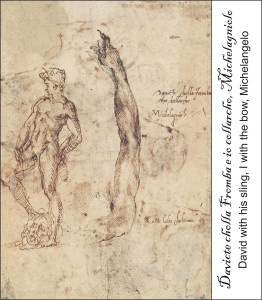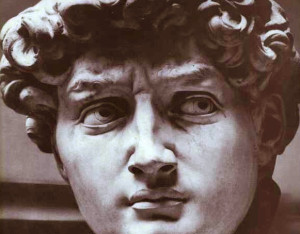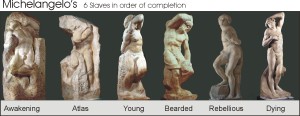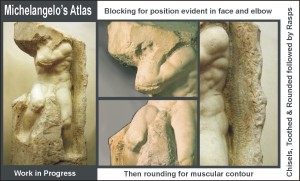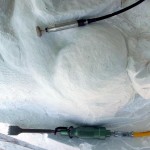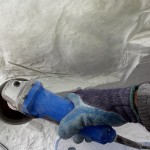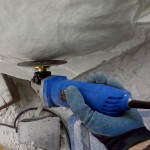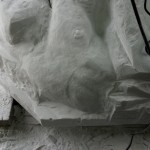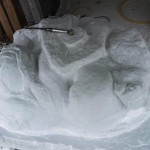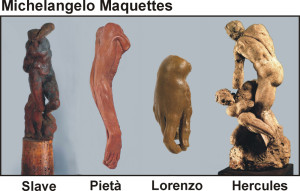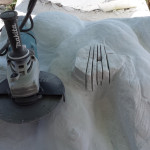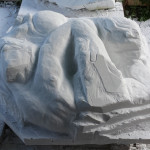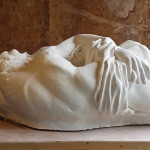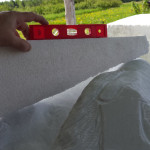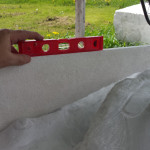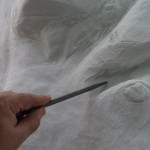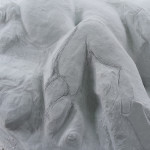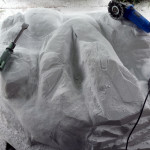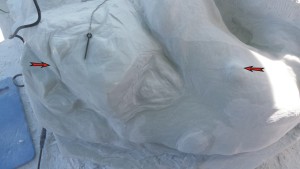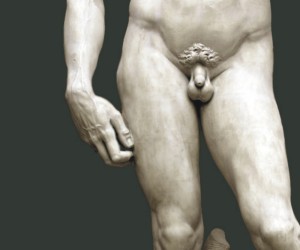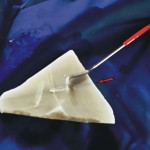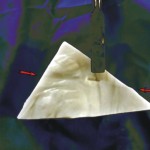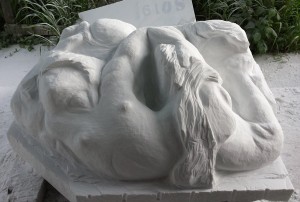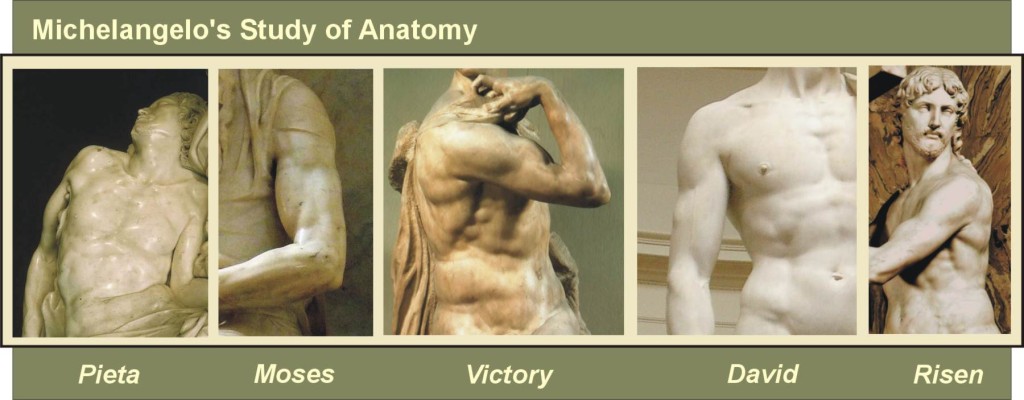Captured Realism
With my Pieta Amare fired to a bisque I can once again focus my attention to the marble Pieta Spero. April is a cool month hear in Atlantic Canada, and with nights still dipping well below freezing and daytime temperatures just inching above zero, all I can do is prepare my stone work site and wait for warmer days just around the corner.
Having several statues on the go at the same time ensures that, regardless of the seasonal temperature, I’m always busy advancing my art, switching from one project to another. The trick is to not get lost in the creative process, and never actually get around to finishing any of the work. Currently I have four statues on the go…. The Pieta Spero, and Pieta Amare, The Pear, and Bruisin
All are, to varying degrees, along the road to completion.
This is the difficulty with the creative mind… it is leaps and bounds ahead of the creative process. There are so many designs that I would like to do, but am trapped within this temporal egg timer.
Not enough hours in the day, not enough days or months; why are there only four seasons in a year, and so few years and just one life.
Michelangelo pined that if he could have more lifetimes to dedicate, he would carve a colossus from the cliffs of Carrara.
Time is scarce, and this is why many artist prefer not to finish… or ‘Non Finito’; an artistic style that Curators and Critics applaud, and was credited to Michelangelo as its originator. What better way to witness the creative process than to trace the chisel marks or suppose what truths are trapped behind the un-carved stone.
In truth, the master had too many great ideas, too many commissions on the go, and was far too optimistic on how much he could actually complete. Pope Julius ll Tomb, was originally intended to have forty full figured statues, more than any one sculptor could complete in a lifetime. In fact most of Michelangelo’s statues were left Non Finito.
Michelangelo never intended to advance this unfinished style. When he had the time, he carved and polished to perfection. Consider; Vatican Pieta, David, Madonna of Bruges, and Moses. Also consider his monumentous achievement, The vault of the Sistine Chapel and The Last Judgement. His greatest works were all masters of completion. His Non Finito Style was simply a result of not being able to turn down a hefty commission.
In modern times, the non realistic statue is the norm; cubism, geometric abstraction, natural stone, rough, unpolished. All these expressions have the aesthetic value of balancing the visual with the emotional… but this was not the Renaissance way. As this period progressed from Michelangelo, to Giambologna, then transitioning to Bernini, the intent was always to compel emotion through captured realism.
Unfortunately, the Achilles heel to this Renaissance style is time. And this form of art is very time-consuming, and as such, very expensive.
As much as anything, the move away from realism to geometric modernism was a product of necessity. Non Finito is less expensive.
Michelangelo and the Bow Drill
The Bow truly is the innovation that subdued our species. Transformed us from wild wonderers to social builders. The Bow pre-dates agriculture, and is more significant than the development of the written word. Could our societies exist today without the invention of the Bow?
Did Michelangelo understand the power of this tool to bend this world to his vision? To shape history as David shaped the Hebrew nation?
Within an afterthought, the briefest of prose, he writes:
Davicte cholla Fromba e io collarcho, Michelagniolo
David with his sling, I with the bow, Michelangelo
David with his sling, I with the bow…. With this simple tool, Michelangelo transformed metamorphic rock Epochs old, into a cultural statement that defined his time and continues today to reflect our humanity… Within David’s eyes is revealed the strength, the confidence that we all have to chose our own path.
Michelangelo had a personal connection to the Bow. Specifically, the Bow Drill, a tool that he used with such precision as to render completely natural the flowing contours of fabric and locks of curly hair.
It amazes me how such a powerful tool has gone virtually unchanged for close to 10,000 years
The bow drill was developed several millennia after the hunting bow. From our stone age ancestors who developed the wooden doweled drill to master fire.
The Neolithic Mehrgarh peoples of what is now central Pakistan redefined the traditional Bow and Arrow, to a method of fire starting, an idea that spread west to Ancient Egypt circa 3000 BCE where the first clear evidence of the drill was in use for carpentry. Out of Africa this novel tool moved east through china, finding its way across continents and influencing the Thule peoples circa 1000 BCE; now the Inuit peoples of Northern Canada.
The Romans wrote at the turning of the common era, of how sculptors would imbed diamonds into steel to better the grinding affect.
Venetians of the 14th century would develop this age old tool into an industry to aid in the carving of glass.
Then into the hands of Michelangelo to create the spark of divine in David’s stare.
Technology found in the Bow Drill was virtually unchanged from 7th millennia BCE through to the industrial revolution when further development of Tungsten Carbide, sintered or brazed diamond tools were developed in the early 20th century.
Modern tools make lighter work and faster production… but unfortunately our world has lost patients for invested time…. Subtle expression and detailed finished work takes time, time is money.
The devil is in the details
Michelangelo's Slaves
I have a special place in my heart for Michelangelo’s unfinished works… most abundantly found in the collection of statues partially carved for Pope Julius II Tomb. The series of six Slaves, to varying degrees, show step by step the masters creative thought, his planning and execution.
From the Awakening Slave still trapped within it’s megalith, through to the perfection of the completed Dying Slave, we see the unison of a singular method. Michelangelo’s gift from God, his representation of perfection within the human form. Classical Realism.
Of these, Atlas is the finest example of Michelangelo’s method. His effective use of available stone. Blocking techniques used to anchor his modelled concept within the mass. As seen in the partial carving of the face and initial rough cutting of the elbow. This then is followed by the rounding of the stone; again evident in the comparative elbow and mid arm. This was done with the point, toothed then rounded chisel, with the rasp smoothing out the surface.
Its no wonder how many of his contemporaries and today’s art historians fall under the spell of Michelangelo’s ‘il terrible’ and consider his work as ‘non finito’. The master’s overpowering skill and creative flow lend even unfinished work the air of completion.
As I have mentioned earlier, Michelangelo would never have wanted his work revealed until it was fully complete. The mystery of creation preserved. However, by studying the Slaves as a series, we now have the privilege to peak behind the curtain and see how hard planning, hard work and artistic nuance can shape a thing of beauty.
Of course, Michelangelo was exceptionally talented, and we who are less adept may fear to follow… but then nothing would get done… so I continue to chip away.
Now that my stone has been blocked, it is ready for rounding. Chisels and rasps are still used today, but their speed has increased with mechanization.. Pneumatic hammer now hammer the chisel and drills now spin the rasp. Though hand tools are still best for quick adjustment, and later for fine or sensitive work.
The purpose is to round out our blocked statue; removing angled edges and revealing a rounded form. You may want to hide this work from curious eyes… my favourite comment from a well intentioned neighbour was “and what exactly am I looking at?” You may know where your going, but others may be lost in the mix. Just think of this as the awkward growing phase… the ugly duckling.
It's tempting to just release your artistic forces and throw caution to the wind; certainly it's quicker… but then there is good reason to regularly revisit your original maquette design.
Michelangelo certainly invested much time into his smaller scale models, and from these he could ensure the grace and majesty he imagined would continue to transfer to his marble…
The model is key to ensuring your chisel stays on course. Angles and expressions, curves and subtleties are often realized in the clay maquette, but lost in translation to stone. You have devoted so much thought to your message…. The strength of sorrow, the passion found in purpose, the embrace of life and death, all represented within the pyramidal yin-yang. This ideal is now trapped in the stone and is relying on you to release it from its bonds.
Michelangelo believed the artist ultimate purpose was to reveal the ideal human form that was trapped within the marble… the stone did not inspire the vision, but was chosen because it conformed to his vision. This is a significant difference from the renaissance style of sculpting to both modern and traditional art techniques.
And so we continue to look back to the maquette. With my Pieta Spero, I want to ensure the pyramid angle remains true. And this is best done with angles and levels. Today we use the Spirit Level invented in the late renaissance period, Michelangelo would have been more familiar with the Roman water level, which when combined with plumb lines, geometric angles and the pointing chisel would perform the same duty. With the level and angle, I can quickly see that my stone rest comfortably below my angle and so I can carve down until the bubble is balanced.
Always remember that the stone does speak to you… guiding you along your way… You may remember from a previous post that you need to keep a close eye on flaws as they are revealed; especially when using pneumatic tools.
The angle and general positioning of the arm in relation to the chest are now in line… From this practical work, I really have an understanding of why Michelangelo would first focus his attention on the torso… it's from this central point that all extremities radiate out… The positioning of the torso determines all other angular relationships… More on this later in my next post.
Stress Testing Flaws in Marble
Selecting the best quality marble is an important step that I covered early on, but as I pointed out in that post, finding perfection is impossible. And despite my best efforts to work within the stones limitations, imperfections can appear from deep within.
The dark line that I first uncovered while lowering the shoulder, has revealed itself to be deep, long, and in a particularly visible location. Crossing his face and along the chest.
This could be very series… if this is actually a fracture and not simply a colouration, It could result in my marble splitting in two. What a disaster. So, before I continue hammering I’ll need to test the sensitivity of this flaw.
Michelangelo would also need to asses the stone as he worked. And would have dealt with surprises revealed along the way.
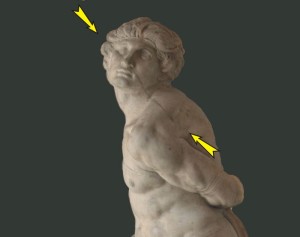 Despite his best efforts to select stone that was as close to perfect as possible, spending weeks examining marble veins high up in the Carrara mountains, his stone still contained weaknesses that needed to be finessed. The clearest example of this can be found in the Rebellious Slave where a dark line angles down and across the face and back.
Despite his best efforts to select stone that was as close to perfect as possible, spending weeks examining marble veins high up in the Carrara mountains, his stone still contained weaknesses that needed to be finessed. The clearest example of this can be found in the Rebellious Slave where a dark line angles down and across the face and back.
Consider also the block used to create David. As I mentioned earlier, this was not only fractured, and weather worn, it was also manhandled, carved and drilled decades before Michelangelo performed his magic.
I often wonder if David’s disproportionately large hand was a result of Michelangelo’s attempt to work around imperfections in the marble. Clear when you examine the added length of the back hand, fingers and thumb in relation to the circumference of the wrist. We may never know.. But certainly, The stone with its imperfections dictated the overall proportions. All artist have to work within the limitations that present themselves…
And so it is with my Pieta Spero.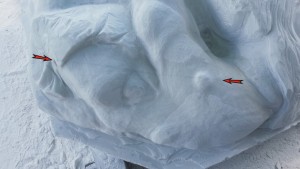
Using an angle grinder to minimize shock, small cross sections of the flaw are removed from the head; a critical area that will soon need to be carved. These are then set aside for testing.
From these sections, the flaw can be stress tested. First I test for changes in hardness by filing across the grain and with the grain. Looking for any differences in hardness and granular texture. Second, I chisel the line to confirm fault or colouration. A fault line is caused by stress and would normally separate into sections. Colouration normally does not crack. Third, with one side firmly grasped in a vice, I hammer the opposite side of the stone with one strong hit. Look to see where the stone cracks.
My three test have proved that this is a fine colouration only… no fault. And that’s good news.
I can continue to round my statue without too much concern of splitting the piece.
Michelangelo’s Study of Anatomy
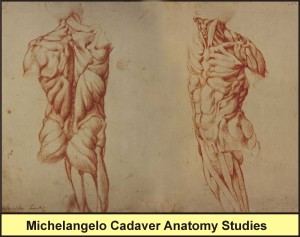 Early in his artistic life, Michelangelo spent years studying anatomy through the dissection of medical cadavers. Though this was forbidden by the Church he moralized that his taboo research was to forward a greater good. His first Pieta, now in St Peters clearly displays his knowledge of muscle tone and muscle placement; an uncanny accuracy that he continued to apply throughout his life’s work.
Early in his artistic life, Michelangelo spent years studying anatomy through the dissection of medical cadavers. Though this was forbidden by the Church he moralized that his taboo research was to forward a greater good. His first Pieta, now in St Peters clearly displays his knowledge of muscle tone and muscle placement; an uncanny accuracy that he continued to apply throughout his life’s work.
Fortunately today we don’t have to clandestinely divert unfortunate souls from their final journey. By comparing accurate medical resource to our model we can ensure all the twist and turns stay aligned with reality.
When this is compared to our marble, we can quickly see what is out of place. The trick is to keep working the stone in the round… slowly moving the marble inward to conform to the vision in your minds eye. As I mentioned in a previous post, Michelangelo would typically focus all his initial attention to the torso.
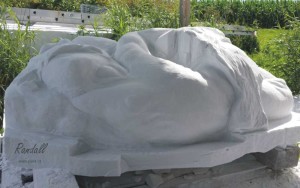 There is no sense in finishing the hands or arms until the mid section is well positioned… the body extends from its centre. You can see from my Spero, that as I pivot the chest to the left, Jesus’ thigh is moved forward and down. This then slides his leg forward and forms the final lines of both his shoulder and Mary’s forearm.
There is no sense in finishing the hands or arms until the mid section is well positioned… the body extends from its centre. You can see from my Spero, that as I pivot the chest to the left, Jesus’ thigh is moved forward and down. This then slides his leg forward and forms the final lines of both his shoulder and Mary’s forearm.
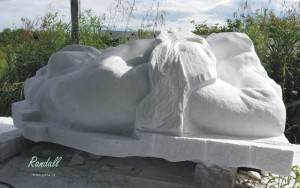 With these extending lines correctly adjusted in relation to the positioned chest, I can start to turn my attention to the extremities as they make contact with each other… Shoulder to chest; and Mary’s hand on Jesus thigh. I can also start to see the relationship between Mary's face and the heel she weeps on.
With these extending lines correctly adjusted in relation to the positioned chest, I can start to turn my attention to the extremities as they make contact with each other… Shoulder to chest; and Mary’s hand on Jesus thigh. I can also start to see the relationship between Mary's face and the heel she weeps on.
With this simple slight clockwise turn and inward adjustment of his chest, I had to move Mary’s hand down by almost two inches… and angle Jesus right hand down several degrees. So, again, by following the Marble Master’s Method I can now turn my attention toward following the chest out to the left arm and right leg… saving this for the next post.


